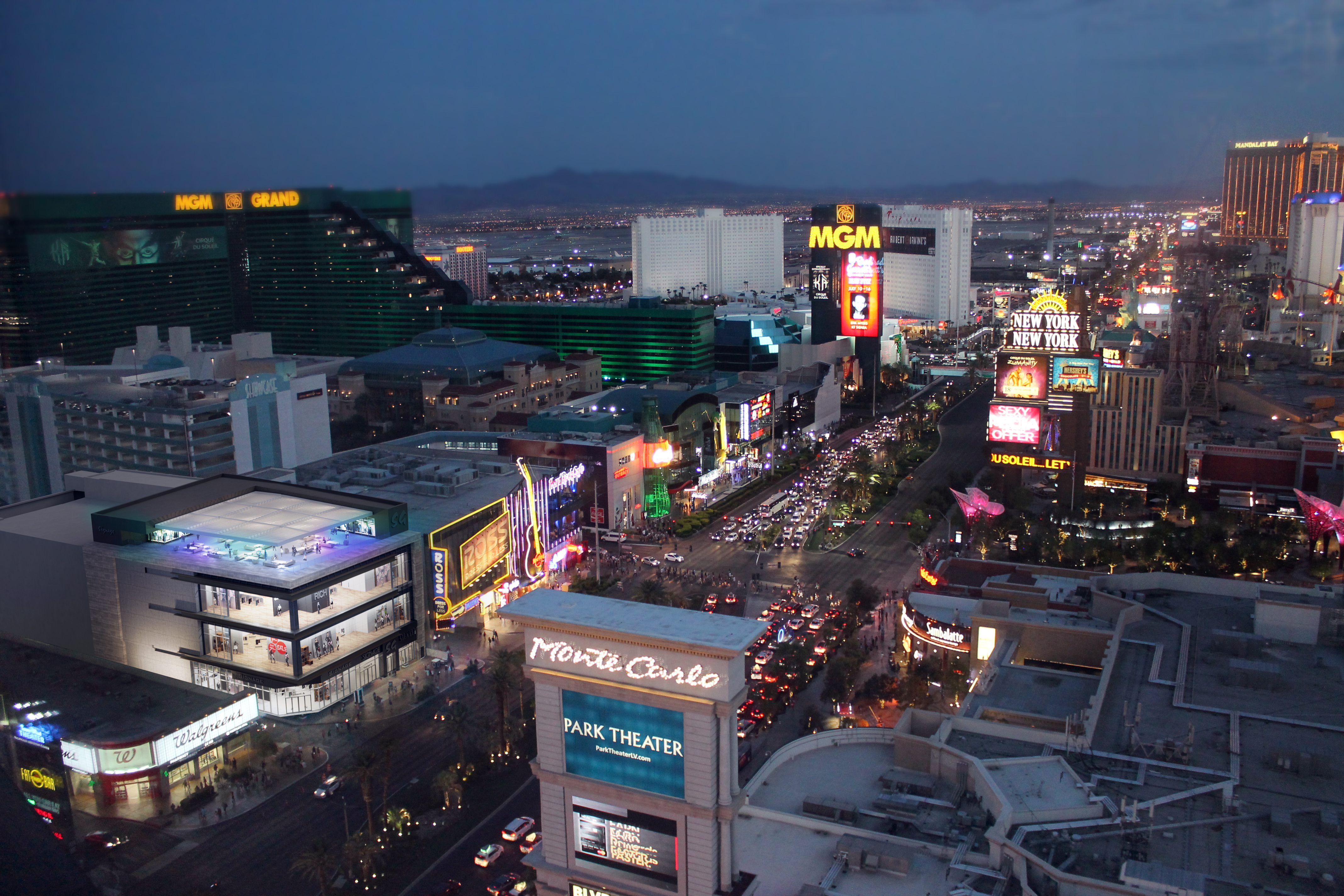A sleek, new, three-story, 145,000-square-foot, glass-clad building on the Las Vegas Strip strikes a contrast to splashy neighbors like the New York, New York Las Vegas Hotel & Casino. The building expands Showcase Mall’s square footage by 43 percent and is now home to a 50,000-square-foot, basement-level Burlington and a 20,000-square-foot Target. A 12,600-square-foot Olive Garden is on its way, as is an as-yet unnamed rooftop bar and restaurant. These offerings will give visitors options that previously were not widely available on the Strip: affordable dining and shopping from well-known tenants.
When Gindi Capital learned that the original 336,429 square-foot mall, just north of the MGM Grand, was for sale in 2014, the investor was known mostly for its East Coast retail properties. The Strip, too, was known for something different. Property owners on the Strip “took a very inward design, where they tried to suck you into their properties,” explained Mark Mikelson principal and Las Vegas retail studio director for architecture firm Nadel. “Once inside, you had your choice of bars or restaurants and gaming or shopping,” and those offerings tended to be specialized and higher end.
More recently, owners have started looking to “take the inside outside,” Mikelson said. Casinos created outdoor entertainment districts to court pedestrians. Bars and patios started opening on the boardwalk. As the Strip became the actual show, Mikelson said, Gindi came to believe there was an opportunity for a new market: visitors looking for more affordable, streetfront shopping and dining options. The company also saw a niche for popular, internationally known retail brands like Target that didn’t yet have much of a presence on the Strip.
How the new property came to be
In 2014, Gindi purchased part of the Showcase Mall for $145 million. Then, in 2017, Smith & Wollensky, which owned the three-story, freestanding building next to the mall, announced it would close the restaurant, planning to relocate to the Grand Canal Shoppes at The Venetian Resort Las Vegas. Gindi acquired the property for $59.5 million, and its plan to replace the steakhouse with a new building that would serve as an expansion to Showcase Mall was approved shortly after. Gindi also has purchased the rest of the mall.
The investor brought on Nadel to lead the renovation. Gindi wanted the new building to look modern and urban, with a glass front to differentiate from its neighbors. Signage was also important. “Fifty or 60 million people walk up and down the street a year,” Mikelson said. To potential tenants, the expansion was not just a retail opportunity but a marketing one. The goal was to make the retailers’ signs as iconic and recognizable as the 10-foot Coca-Cola bottle that juts from Showcase Mall’s facade. Target and Burlington’s signage is pictured at top.

In this photo illustration, Showcase Mall, with its iconic giant Coca-Cola bottle, sits at center, and the three-story, glass-front expansion that replaced Smith & Wollensky is rendered to the left
Nadel started design work on the expansion in 2016; construction was expected to end in December 2019, and the opening was slated for February 2020. Then COVID-19 hit. Target and Burlington delayed their openings, and as retailers like JCPenney and Neiman Marcus declared bankruptcy, some analysts predicted the end of retail real estate. Nadel chairman and principal Greg Lyon felt differently: “The wonderful thing about retail is: There’s always a disruptor. In the ’50s, it was the Sears catalogues. Then it was online [sales] and then, of course, the pandemic. What we see from all these trends is that retail has a great ability to evolve and to adapt.”
Nadel believes Showcase Mall is a prime example of brick-and-mortar retail’s resiliency. “The uses of the building — daily needs and apparel — have found a place in an unlikely environment, the Strip,” Lyon said. “This shows me how retail, in all capacities, can really adapt to the environment.”
Mikelson says Target and Burlington have been bustling since opening their doors in May, and he expects those numbers to expand once COVID-19 vaccines become more widely available. “We are not very far from being back to our new normal, which will be conventions running again, concerts, hockey games, all the things that bring people here,” Mikelson said. “We’re very well-positioned for when the floodgates open again.”
By Rebecca Meiser
Contributor, Commerce + Communities Today and Small Business Center